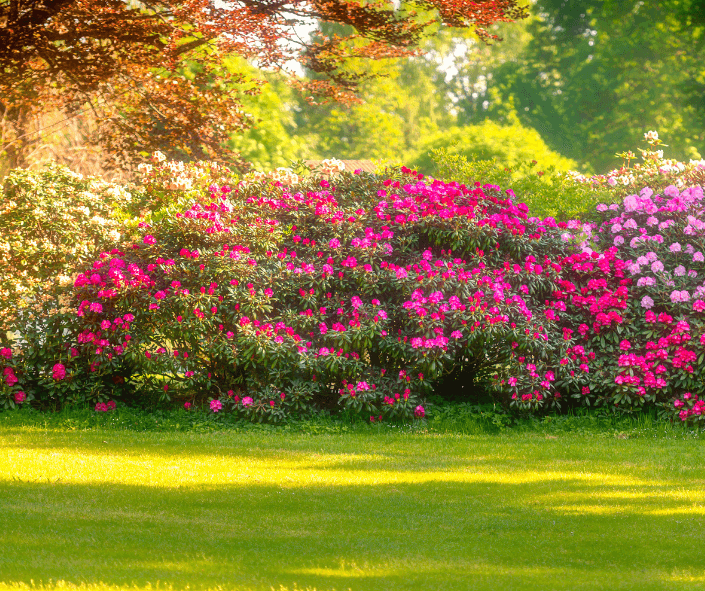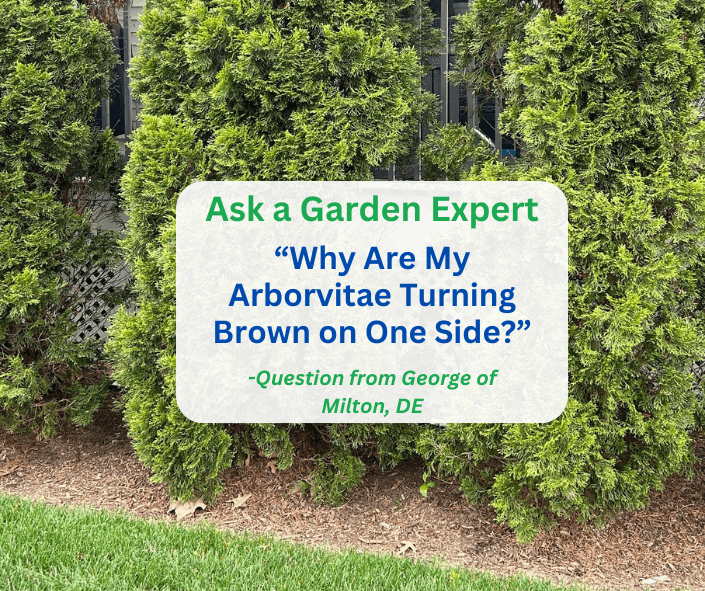“My Emerald Green arborvitae (Thuja occidentalis ‘Smaragd’) trees were planted by a professional landscaper along the outside of our screened-in porch in February 2019. In the first 3 years, they were lush and full. In the past 2 years, they have lost all of their needles in the side closest to the screen, have become spindly, and show no signs of new growth. What can we do to repair the damage? Have attached 3 photos. HELP!!! Thank you!” Question from George of Milton, Delaware
Answer: Emerald Green arborvitaes are tall, columnar, evergreen shrubs (15 feet by 3-5 feet) that require full sun (6 or more hours a day) on all sides to remain green all around. Sadly, yours have lost all foliage facing the shaded screen due to lack of light, while the sunnier side has maintained foliage. Moreover, based on the photo, it appears they may be competing for light beneath shade trees during part of the day, and the tall shrubs are planted too closely together too close to your porch. Lastly, their tall height prevents you from being about to see outside your porch, if you value your view.
Even with pruning and care, your trees will not develop healthy, green foliage on the shaded porch side, because there simply is not enough light. If the shrubs were moved, they may have a chance, though they are quite large. You might consider replanting shorter evergreens tolerant of shade. I am familiar with Milton, Delaware, and the area around Lewes and Rehoboth. I recommend planting an attractive shrub tolerant of lower light and the sandy, coastal-plain soils of Sussex County. I’ll recommend some good evergreen and non-evergreen shrub options.
Shrub Recommendations

Inkberry (Ilex glabra cultivars). The native shrubby evergreen is tolerant of partial shade, unlike most evergreen hollies. There are many quality varieties available for sale. According to an extensive study at Longwood Gardens, ‘Densa‘ was the best-performing variety trialed. It reaches a mature height of 4-7 feet and is easily pruned. The 5-foot ‘Shamrock‘ is another notable variety to look for, and Proven Winners has introduced several other good inkberries. Give them plenty of water, especially as they are becoming established in the first year.
Azaleas or Rhododendrons may be evergreen or deciduous and quite a few grow beautifully in the area. the evergreen PJM Hybrid Rhododendron (4-6 feet at maturity, Zones 4-7) is a good option with an attractive, rounded habit, lavender-pink flowers that bloom in mid-spring, and evergreen foliage (dark green in summer and reddish in winter). It is tough, reliable, and tolerant of shade.
Hydrangeas provide a good deciduous option with summer flowers. I favor dwarf varieties of oakleaf hydrangea (Hydrangea quercifolia), like Ruby Slippers, or a smooth hydrangea (Hydrangea arborescens) like the tough, 5′ x 5′ Lime Ricky.
Contact the Delaware Center for Horticulture for more good shrub ideas.
Before planting any new shrubs, consider amending your soil with organic matter to fill in the sandy pore spaces and hold water and nutrients. Black Gold® Natural & Organic Garden Compost Blend or peat moss are good, organic options.
Happy gardening,
Jessie Keith
Black Gold Horticulturist



